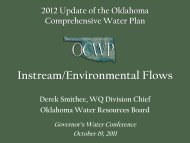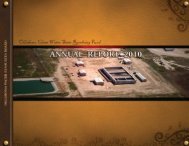Hazard Potential Classification Systems for Dams, FEMA 333
Hazard Potential Classification Systems for Dams, FEMA 333
Hazard Potential Classification Systems for Dams, FEMA 333
You also want an ePaper? Increase the reach of your titles
YUMPU automatically turns print PDFs into web optimized ePapers that Google loves.
PREFACE<br />
In April 1977, President Carter issued a memorandum directing the review of federal dam safety activities by an<br />
ad hoc panel of recognized experts. In June 1979, the ad hoc interagency committee on dam safety (ICODS)<br />
issued its report, which contained the first guidelines <strong>for</strong> federal agency dam owners. The Federal Guidelines <strong>for</strong><br />
Dam Safety (Guidelines) encourage strict safety standards in the practices and procedures employed by federal<br />
agencies or required of dam owners regulated by the federal agencies. The Guidelines address management<br />
practices and procedures but do not attempt to establish technical standards. They provide the most complete and<br />
authoritative statement available of the desired management practices <strong>for</strong> promoting dam safety and the welfare<br />
of the public.<br />
To supplement the Guidelines, ICODS prepared and approved federal guidelines in the areas of emergency<br />
action planning; earthquake analysis and design of dams; and selecting and accommodating inflow design floods<br />
<strong>for</strong> dams. These publications, based on the most current knowledge and experience available, provided<br />
authoritative statements on the state of the art <strong>for</strong> three important technical areas involving dam safety. In 1994,<br />
the ICODS Subcommittee to Review/Update the Federal Guidelines began an update to these guidelines to meet<br />
new dam safety challenges and to ensure consistency across agencies and users. In addition, the ICODS<br />
Subcommittee on Federal/Non-Federal Dam Safety Coordination developed a new guideline, <strong>Hazard</strong> <strong>Potential</strong><br />
<strong>Classification</strong> System <strong>for</strong> <strong>Dams</strong>.<br />
With the passage of the National Dam Safety Program Act of 1996, Public Law 104-303, ICODS and its<br />
Subcommittees were reorganized to reflect the objectives and requirements of Public Law 104-303. In 1998, the<br />
newly convened Guidelines Development Subcommittee completed work on the update of all of the following<br />
guidelines:<br />
• Federal Guidelines <strong>for</strong> Dam Safety: Emergency Action Planning <br />
<strong>for</strong> Dam Owners <br />
• Federal Guidelines <strong>for</strong> Dam Safety: <strong>Hazard</strong> <strong>Potential</strong> <strong>Classification</strong> <br />
System <strong>for</strong> <strong>Dams</strong><br />
• Federal Guidelines <strong>for</strong> Dam Safety: Earthquake Analyses and Design of <strong>Dams</strong><br />
• Federal Guidelines <strong>for</strong> Dam Safety: Selecting and Accommodating Inflow Design<br />
Floods <strong>for</strong> <strong>Dams</strong><br />
• Federal Guidelines <strong>for</strong> Dam Safety: Glossary of Terms<br />
The publication of these guidelines marks the final step in the review and update process. In recognition of the<br />
continuing need to enhance dam safety through coordination and in<strong>for</strong>mation exchange among federal and state<br />
agencies, the Guidelines Development Subcommittee will be responsible <strong>for</strong> maintaining these documents and<br />
establishing additional guidelines that will help achieve the objectives of the National Dam Safety Program.<br />
The members of all of the Task Groups responsible <strong>for</strong> the update of the guidelines are to be commended <strong>for</strong><br />
their diligent and highly professional ef<strong>for</strong>ts.<br />
Harold W. Andress, Jr. <br />
Chairman, Interagency Committee on Dam Safety


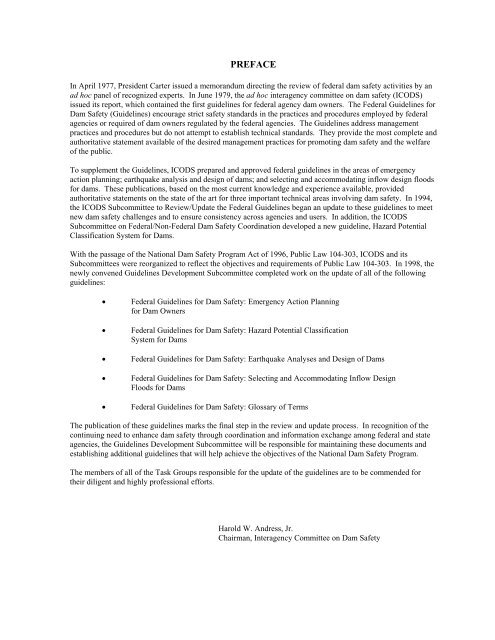


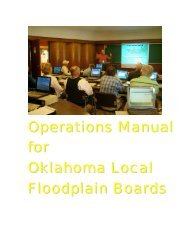
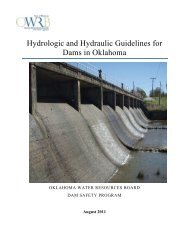


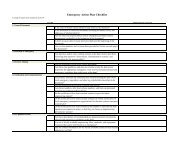


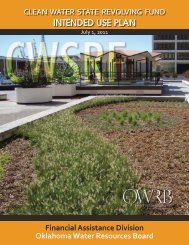

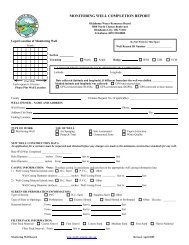
![A Commodity & a Resource [pdf] - Water Resources Board - State of ...](https://img.yumpu.com/42536671/1/190x143/a-commodity-a-resource-pdf-water-resources-board-state-of-.jpg?quality=85)
